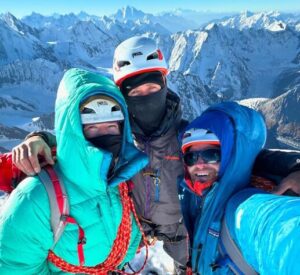In late summer, four Slovenian women climbed four new, highly committing routes in the remote Lalung Valley of the Indian Himalaya. Their expedition included the first ascent of 6,243m Lalung I, which they completed in pure alpine style.
The team
The team comprised four strong climbers supported by the Alpine Association of Slovenia: Anja Petek, Patricija Verdev, Ana Baumgartner, and Ursa Kesar.

The Slovenian team. Photo: Patricija Verdev
Petek is a prominent Slovenian alpinist with climbs in Kyrgyzstan, Peru, and the Alps. She made the second winter ascent of the Cop Pilar on Triglav, Slovenia. Verdev has climbed in the Alps and the Tatra mountains. Baumgartner has focused on the Central and Slovenian Alps, and Kesar has climbed in Peru and Kyrgyzstan.
At the end of August, the team traveled to Zanskar in the southwest of Ladakh, India. On August 26, they set off with 18 porters for the Lalung Valley. They hoped to explore a few of the region’s peaks, only fairly recently reopened to climbers, but their main goal was unclimbed 6,243m Lalung I.
Base camp
Even the local porters didn’t know the area very well. Before starting the approach, they told the climbers that their base camp would be at around 5,000m. It was, in fact, at 4,000m.
The day after they arrived at base camp, the Slovenians explored higher up the valley. According to their report for the American Alpine Journal, it took an entire day to make the 20km round trip on moraine and glacial terrain. The weather was poor, and they didn’t see much of the higher peaks.
Next, they split into two groups. Petek teamed up with Verdev, and Baumgartner joined Kesar. Both targeted different goals.

Ursa Kesar, Patricija Verdev, Anja Petek, and Ana Baumgartner. Photo: Anja Petek
New route
On August 31, Verdev and Petek climbed a new route on a granite north-northwest face, not far from their base camp. This buttress, which starts at around 4,200m, lies on the south side of the valley and rises to 5,332m. According to Petek, only one route had previously been climbed here. That route was near the center of the face, completed by Indian climbers Korak Sanyal and Spandan Sanyal in 2017.
Verdev and Petek climbed their new 1,400m route in 15 hours. They named it Connection (VI-/V-IV).

Two new routes by Ana Baumgartner and Ursa Kesar: ‘BC (Bear Camp)’ and ‘Calm Before The Storm?’ on the unnamed 5,332m Peak. Photo: Ursa Kesar
Bears and more new routes
Before moving up to an advanced base camp, the Slovenians had a nocturnal visit from a bear. This became a theme: Bears trying to steal food made at least 10 visits to base camp during the expedition. Later, the bears destroyed tents, too.
After the first bear visit, the climbers were happy to relocate to a bear-free advanced base camp at 4,800m.

Rapping down on Peak 5,332m. Photo: Ana Baumgartner
Between September 10 and 13, Baumgartner and Kesar climbed two new routes on the north-northwest face of Peak 5,332m, finishing on the northwest ridge. On September 10, this duo finished a new 800m route in eight hours. Three days later, they climbed another route, this one a difficult, rocky 670m line.
The first ascent of Lalung I
On September 9, the Petek-Verdev duo left advanced base camp for the east ridge of unclimbed 6,243m Lalung I. They camped a little way above the start of their route.
They had a forecast for a good weather window, but a snowstorm the next day forced them to set up a tent in the middle of the day and sit out the bad weather. The storm lasted throughout the next day, but September 12 dawned clear, and Petek and Verdev climbed late into the night.

On the second day of the ascent of Lalung I. Photo: Anja Petek
“Day five on the ridge required even more determination, and it wasn’t until 1:30 am that we settled down for a rest, having climbed the final difficult mixed pitches,” Petek recalled.
Because of the strong wind, they lost their tent poles and had to sleep in the open in bivouac sacks.
The next morning, fog made it hard to navigate. When they were 30m below the summit, the sun finally broke through. On July 14, at 9 am, the two climbers topped out. It is the first known ascent of Lalung I.

The fourth climbing day on Lalung I started with a sunny morning. Photo: Anja Petek
The descent
After summiting, Petek and Verdev proceeded with a long descent along the west ridge and then five rappels on the north face to reach the glacier at 6:30 pm. It took them another eight hours to reach the advanced base camp. The next day, they descended to base camp.
They named the 2,000m route Here Comes The Sun (ED, M6+, AI5+). ED stands for Extremely Difficult, the highest level of the French six-point scale.

Lalung I and the route of the first ascent, marked in yellow. Photo: Patricija Verdev
Back home in Slovenia, Verdev told ExplorerWeb about the ascent of Lalung I, including how the terrain on the ridge was harder than it appeared from the north-northwest side of the mountain.
“This expedition was successful because we all came home with smiles on our faces,” Verdev told us.
Recently, Petek and Verdev won the international Steel Angel Award for their ascent.

Verdev and Petek receive their Steel Angel Award. Photo: Steel Angel Awards






